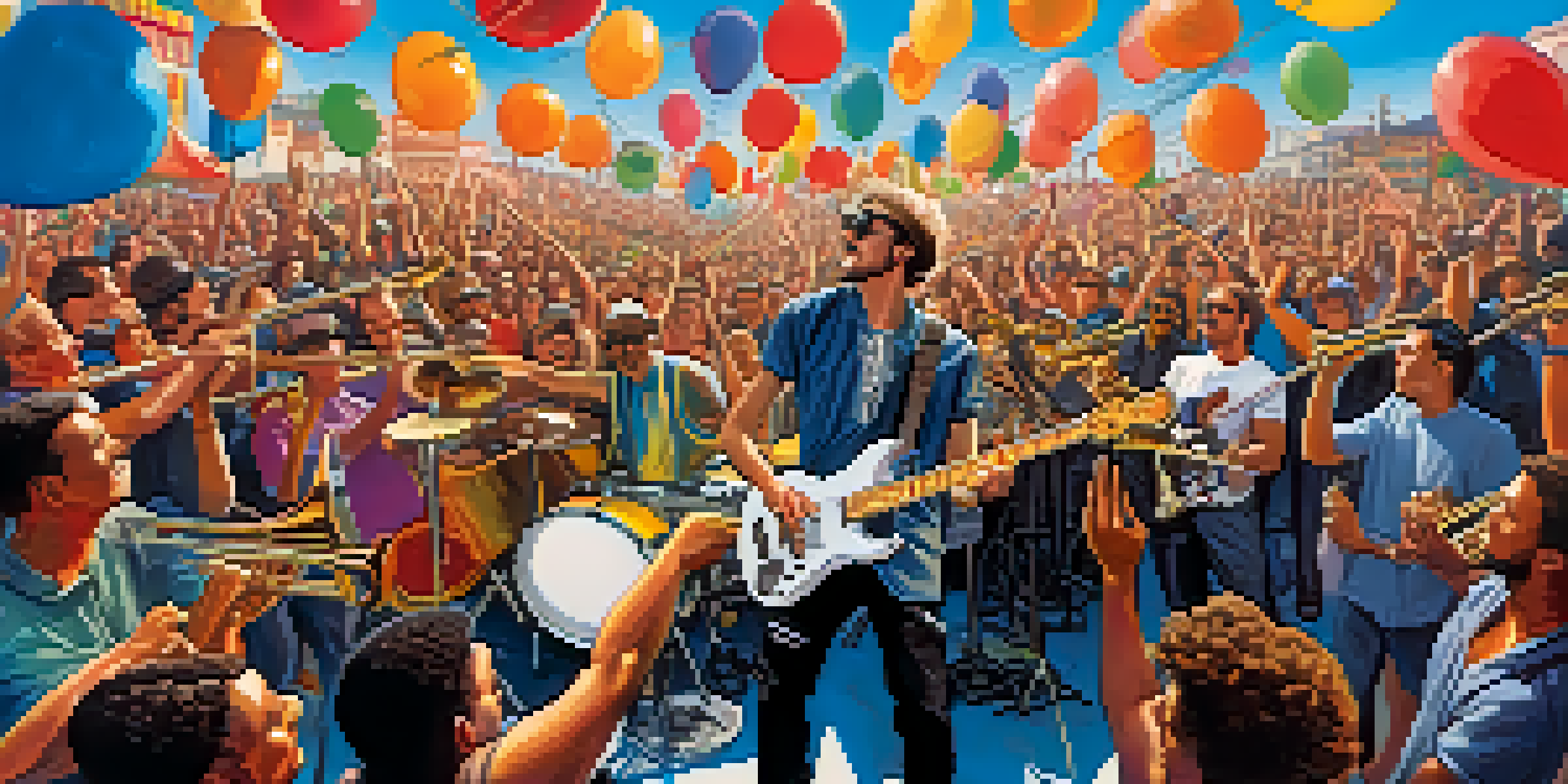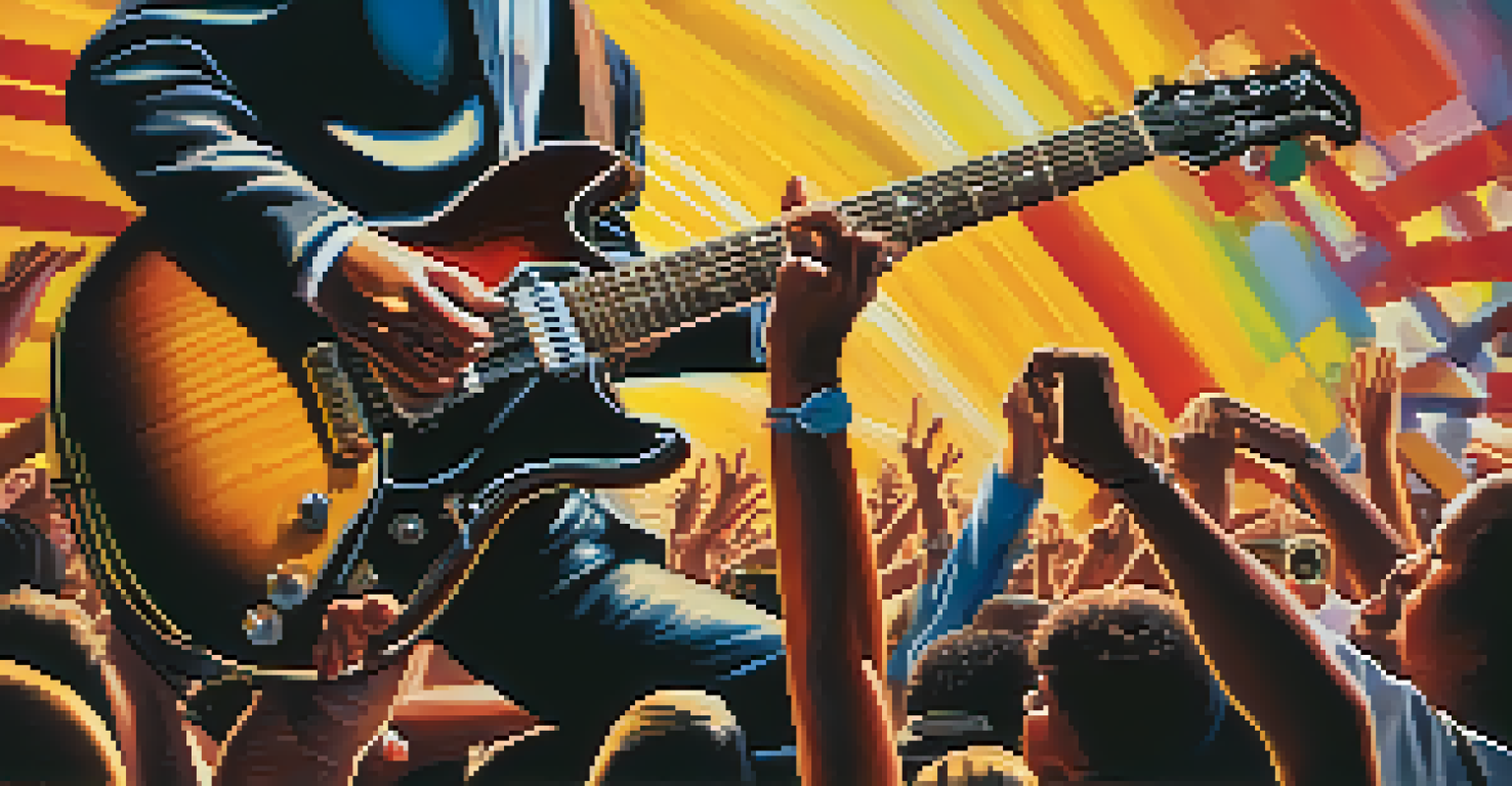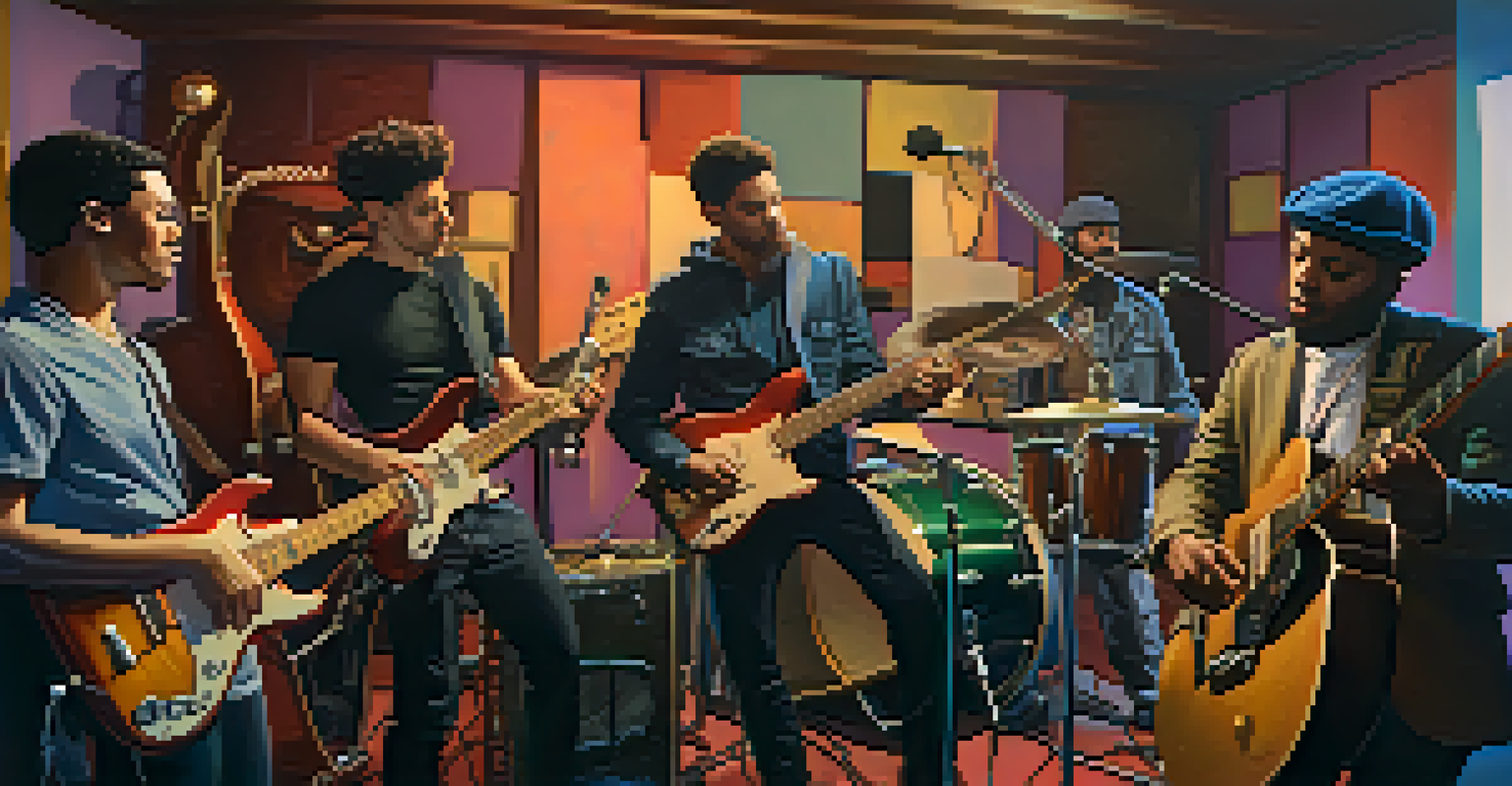Exploring Guitar Roles in Ska Bands and Their Energetic Vibe

The Heartbeat of Ska: Understanding Its Unique Sound
Ska music is a lively genre that originated in Jamaica in the late 1950s, combining elements of jazz, rhythm and blues, and Caribbean mento. Its upbeat tempo and distinctive offbeat rhythm create an infectious energy that invites listeners to dance. The guitar plays a crucial role in this sound, delivering those sharp, staccato chords that drive the music forward.
Ska is a music that invites everyone to dance and be happy, a celebration of life itself.
Think of ska like a vibrant street festival, where each instrument contributes to the overall celebration. The guitar, with its punchy riffs, acts as a lively banner waving in the wind, capturing the attention of the crowd. It's this unique interplay between the guitar and other instruments, like the horns and drums, that defines the ska sound.
As you dive deeper into ska music, you’ll realize how the guitar's rhythm complements the upbeat brass and percussive elements. This synergy creates a layered texture that keeps audiences engaged, making them want to move their feet. In essence, the guitar in ska is not just an instrument; it's a crucial element of the genre's infectious vibe.
The Guitar's Role: Rhythm vs. Melody in Ska
In ska, the guitar often serves dual roles: providing rhythm and adding melodic elements. The rhythm guitar typically strums short, sharp chords on the offbeat, creating a sense of urgency and excitement. This technique, known as 'chopping,' forms the backbone of the ska rhythm section, allowing the horns and vocals to shine.

Contrastingly, lead guitarists in ska bands may take on the role of melody-makers, adding catchy riffs and solos that elevate the music. When a lead guitarist steps in, it’s akin to a painter adding vibrant colors to a canvas; it enriches the sonic experience and captures the listener's attention. This balance between rhythm and melody is what makes ska so engaging.
Ska's Unique Sound and Energy
Ska music combines jazz, rhythm and blues, and Caribbean elements, creating an infectious energy that invites listeners to dance.
Ultimately, the interplay between rhythm and melody within the guitar parts showcases the versatility of the instrument. Whether it's a driving rhythm or a catchy hook, the guitar is fundamental in maintaining that energetic vibe that ska is known for. This dynamic is what keeps the genre fresh, allowing for both danceable grooves and memorable tunes.
Iconic Ska Guitar Techniques You Should Know
Several guitar techniques have become synonymous with ska music, and mastering these can elevate your playing. One popular technique is palm muting, where the edge of the palm lightly rests on the strings near the bridge. This creates a percussive sound that enhances the characteristic offbeat rhythm of ska.
The guitar is the heartbeat of ska, driving the rhythm while weaving melodies that uplift the spirit.
Another essential technique is the use of skanking, which involves quick, rhythmic strumming patterns. Imagine a drummer's snare hitting in rapid succession; the guitar mimics this energy and keeps the song moving. This technique is often coupled with sharp chord changes, making it a staple in ska performances.
Finally, incorporating syncopation can add complexity to your playing. By emphasizing unexpected beats, guitarists can create a lively, danceable rhythm that captures the essence of ska. These techniques not only make the music more exciting but also showcase the guitar's ability to drive the vibrant energy that ska is celebrated for.
Famous Ska Guitarists Who Shaped the Genre
Throughout ska's history, several guitarists have left an indelible mark on the genre. One standout is Lynval Golding of The Specials, known for his innovative guitar work that helped define the 2 Tone ska sound in the late 1970s. His ability to blend punk energy with traditional ska elements created a fresh take on the genre.
Another influential figure is Roger Lima from Less Than Jake, who blended ska with punk rock, contributing to the third wave of ska in the 1990s. His catchy riffs and energetic performances exemplified how guitarists could push the boundaries of ska while keeping the dancefloor alive. Lima's work shows the guitar's adaptability as the genre evolved.
Guitar Techniques in Ska
Key guitar techniques like palm muting and skanking are essential for capturing the lively and rhythmic essence of ska music.
These guitarists, among others, have shown how the instrument can shape the sound and feel of ska music. By experimenting with different styles and techniques, they have helped the genre grow and remain relevant. Their legacies continue to inspire new generations of musicians to explore the vibrant world of ska guitar.
The Influence of Ska on Modern Music and Guitar
Ska's infectious energy has influenced a wide range of modern music genres, from pop-punk to reggae and beyond. Bands like No Doubt and Reel Big Fish have incorporated ska elements into their sound, showcasing the guitar's versatility and rhythmic drive. This cross-pollination has expanded the audience for ska and introduced new listeners to its lively vibe.
Additionally, many contemporary guitarists draw inspiration from ska's unique techniques. They often incorporate skanking and palm muting into their playing, creating a fresh sound that pays homage to the genre’s roots. This blend of old and new keeps ska relevant and exciting in today’s musical landscape.
As we see more collaborations between genres, the guitar’s role in ska continues to evolve. Whether it's through the lens of pop, rock, or even hip-hop, the energetic vibe of ska remains a powerful influence. It's a testament to the guitar's ability to connect with audiences across different musical styles.
Creating Your Own Ska-Inspired Guitar Sound
If you're looking to create your own ska-inspired guitar sound, start by focusing on the rhythm. Experiment with upbeat strumming patterns and incorporate the skanking technique. This will lay down a solid foundation for your ska tracks and get those feet moving.
Next, consider the use of effects pedals. A bit of reverb or delay can add depth to your sound, making it more dynamic and engaging. However, be careful not to overdo it; the essence of ska lies in its straightforward, punchy sound. A clean tone often works best to capture that authentic ska vibe.
Influence of Ska on Modern Music
Ska has significantly influenced various modern genres, inspiring contemporary guitarists to incorporate its energetic techniques into their music.
Finally, don't forget to jam with other musicians. Ska is all about collaboration and the interplay between instruments. Bring in a horn section or a drummer who understands the ska rhythm, and you'll find that your guitar work can shine even brighter. Together, you can create that energetic atmosphere that makes ska so irresistible.
The Future of Ska Guitars and Their Vibrant Energy
As music continues to evolve, so does the role of guitars in ska. Emerging artists are blending traditional ska elements with modern influences, creating a fresh sound that resonates with new audiences. This fusion keeps the genre alive while paying homage to its roots.
Moreover, the DIY music scene is thriving, with many bands recording and producing their own ska music. This grassroots movement allows for greater experimentation with guitar techniques and sounds, giving rise to innovative styles. The accessibility of technology has empowered musicians to explore and redefine what ska can be.

The future of ska guitars holds exciting possibilities, with new talent eager to push boundaries. As long as there are musicians passionate about the energetic vibe of ska, the guitar will continue to play a pivotal role in shaping its sound. With each new generation, ska's vibrant spirit remains alive and well.